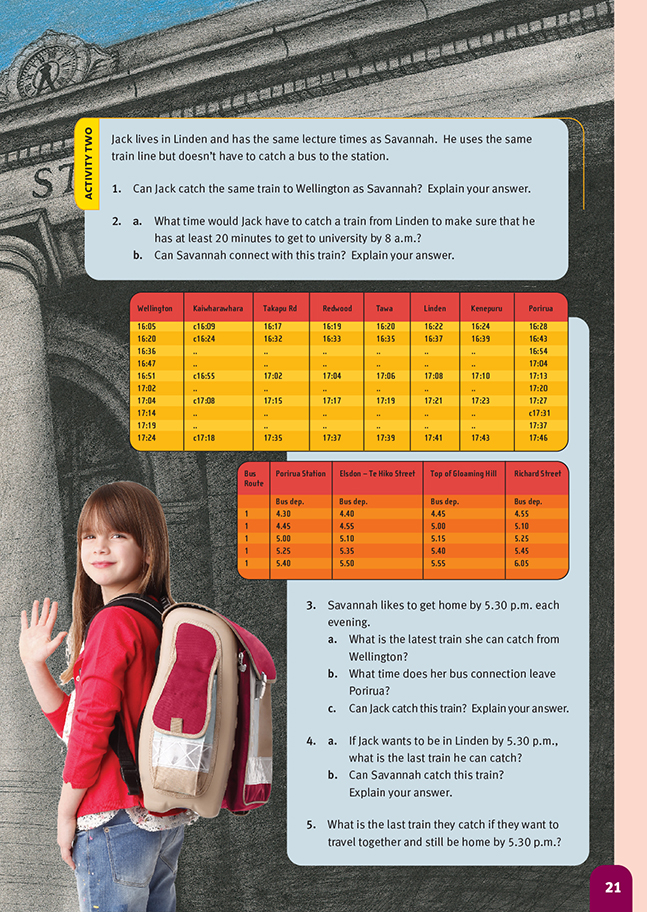This is a level 4 measurement strand activity from the Figure It Out series.
A PDF of the student activity is included.
Click on the image to enlarge it. Click again to close. Download PDF (403 KB)
interpret and use timetables
FIO, Level 4, Measurement, Book One, Ways to Go, pages 20-21
This activity is about reading and interpreting timetables. The bus timetable uses 12-hour time, and the train timetable uses 24-hour time. Make sure that everyone knows how to interpret 24-hour time and why it is needed (especially to avoid confusion where international communications or travel are involved). Students are used to seeing both formats on digital watches, clocks, VCRs, microwaves, ovens, dishwashers, and so on. The bus timetable uses a dot to separate hours and minutes; the train timetable uses a colon. Again, students meet both in everyday life: the colon separator is used on most digital devices, but the dot is normally used in print. They need to be able to understand and use time in both formats.
If you know that your class is likely to have trouble with timetables, prepare them with a class or group discussion. There are plenty of questions that can be asked while leaving the questions in the activity to be done by the students themselves, for example, “When is the earliest Savannah could get to university if she caught the 9.00 a.m. bus from Richard Street?” or “What would be the latest time she could leave home if her first lecture was at 10.00 a.m.?” or “Which bus would she need to catch from Richard Street if she wanted to get the 7.25 a.m. train from Porirua Station?”
As an extension activity, some students may like to investigate how it is that time is based on numbers such as 60, 24, and 7 when we measure everything else (except angle!) in tens. This could extend to an investigation of the numerous imperial measuring systems that were replaced by the metric system. They might investigate
why it is that the US still uses imperial units for most of their measurements.
Answers to Activities
Activity One
1. a. 6.40 a.m.
b. 7.05 a.m.
c. 19 min
d. 47 min
2. a. 8.30 a.m.
b. 9.35 a.m.
c. 1 hr 5 min
Activity Two
1. He can on Tuesdays and Thursdays. He can’t on Mondays, Wednesdays, or Fridays because the train doesn’t stop at Linden.
2. a. 6:48 (6.48 a.m.)
b. Yes. This is the same train that leaves Porirua Station at 6:44 (6.44 a.m.), and as it is not an express, it stops at Linden, where Jack gets on.
3. a. The 16:36 (4.36 p.m.) train
b. 5.00 p.m.
c. No. It’s an express train and doesn’t stop at Linden.
4. a. The 17:04 (5.04 p.m.) train
b. Yes, but if she catches this train, she will have a wait of 13 minutes for the next bus and will get to her stop at 6.05 p.m.
5. The 16:20 (4.20 p.m.) train

